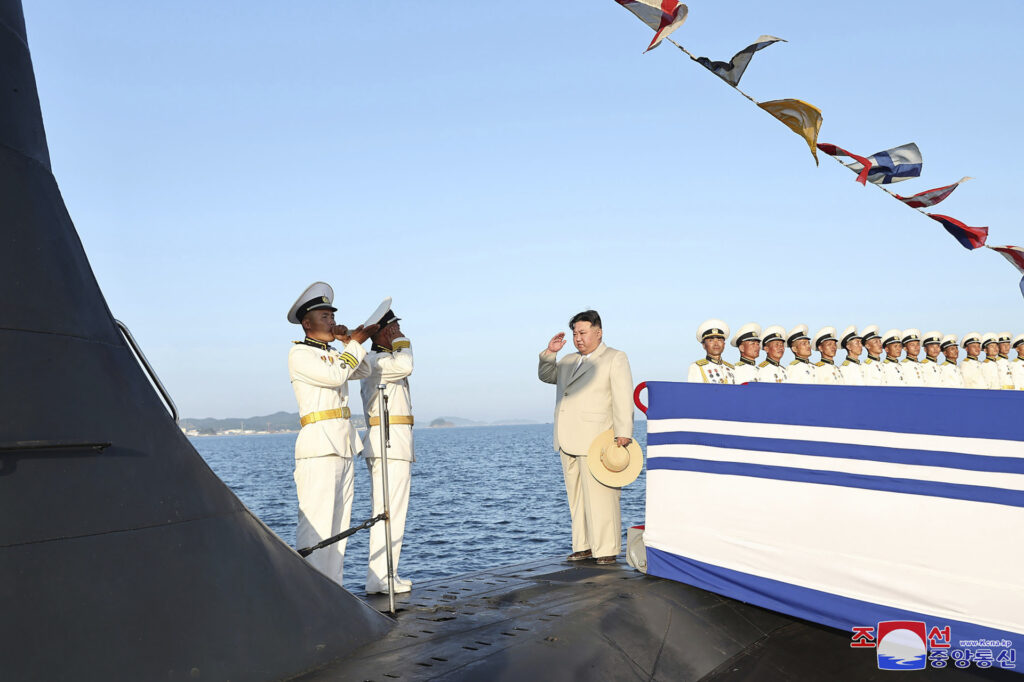North Korea claimed to launch its first nuclear attack submarine on Wednesday in a ceremony attended by a very excited Kim Jong-un, but the South Korean military quickly pointed out that the submarine does not appear operational or capable of carrying a heavy payload of nuclear missiles.
BREAKING: North Korea says it completed nuclear attack submarine pic.twitter.com/paGv9WAe22
— BNO News (@BNONews) September 7, 2023
Dictator Kim Jong-un gushed over the sub at its lavish launch ceremony, which came three days before the 75th anniversary of the founding of the Communist dictatorship. The corpulent dictator looked like the world’s most sinister child unwrapping an unexpected gift on Christmas morning:
Joyful Kim Jong-un at the launch of a submarine pic.twitter.com/70owLs456r
— Sprinter (@Sprinter99800) September 8, 2023
The sub was ostentatiously christened Hero Kim Kun-ok, the name of a famous North Korean naval officer from the Korean War. It appears to be a slight variation on a Russian Romeo-class diesel submarine design, with ten visible missile launch tubes.
The Romeo series was generally considered a failure for the Soviet Union, with a host of serious design and performance issues. The Soviets handed a number of Romeo subs over to China, which, in turn, passed about two dozen of them along to North Korea. Elderly Romeo subs are believed to be operated by the North Korean military to this day.
“These submarines will be equipped with a vast array of nuclear delivery vehicles of varying power and will be poised to launch preemptive and retaliatory strikes at any time underwater,” Kim boasted.

North Korean dictator Kim Jong-un (C) boards a new nuclear attack submarine, “Hero Kim Kun-ok,” at an unspecified place in North Korea on September 6, 2023. (Korean Central News Agency/Korea News Service via AP)
“The nuclear attack submarine, which has been a symbol of aggression against our nation for the past few decades, now symbolizes our threatening power that strikes fear into our unscrupulous enemies,” he said.
Kim said that “achieving rapid development of our naval forces,” including arming them with nuclear weapons, was important due to “the enemies’ recent aggressive moves and military acts.”
North Korea constantly portrays U.S. and South Korean military exercises, like the major exercise completed last month, as “aggressive” actions.
South Korean military intelligence said Kim was considerably overhyping the actual capabilities of the new sub, which probably lacks the range to threaten the United States but could become a security problem for Japan and a threat to the American base on Guam.
“Based on our analysis of the North Korean submarine’s appearance to date, we believe that it appears to have increased the size and shape of some parts, such as the bridge, to accommodate missiles, but it does not appear to be operational,” the South Korean Joint Chiefs of Staff said on Friday.

A new North Korean nuclear attack submarine, “Hero Kim Kun-ok,” at an unspecified place in North Korea on September 6, 2023. (Korean Central News Agency/Korea News Service via AP)
South Korean analysts said there are signs of “deception and exaggeration” in North Korea’s submarine claims, including those missile launch tubes, which appear to have been made larger and more numerous than a Romeo-class sub could conceivably require. Overloading the sub with missiles and launch tubes would make it much easier to detect.
“This submarine, though heavily modified, is based on 1950s Soviet-origin technology and will have inherent limitations. Nevertheless, in terms of complicating the targeting challenges that the U.S. and its allies will face, the submarine will serve North Korea’s purposes,” said Carnegie Endowment for International Peace Analyst Ankit Panda.
Former South Korean Presidential Secretary Cha Du-hyeogn, now a research fellow with the Asian Institute for Policy Studies, said:
The modified submarines put South Korea and Japan under its range, and in theory, Guam as well. However, questions remain regarding its actual capabilities. It is still unconfirmed whether the submarine can withstand a missile strike, move silently underwater, or effectively launch an SLBM [submarine launched ballistic missile] from beneath the surface.
Cha suggested North Korea would require extensive assistance from a more advanced patron like Russia to build its own nuclear missile subs. The Russians are probably not eager to provide what Pyongyang needs, although there has been some speculation that Russia might offer sub technology in exchange for North Korean weapons that could be sent to Russian troops in Ukraine.
“When this thing is field deployed, it’s going to be quite vulnerable to allied anti-submarine warfare, so I think from a sort of hard-headed military standpoint this doesn’t make a lot of sense,” mused Vann Van Diepen, a former U.S. government weapons expert who contributes to the watchdog group 38 North.
On the other hand, Japanese Chief Cabinet Secretary Hirokazu Matsuno said that even a crude North Korean sub capable of launching nuclear missiles would present his country with a new security headache.
“North Korea’s military activity is posing graver and more imminent threat to our country’s security than before,” Matsuno said at a press briefing on Friday.


